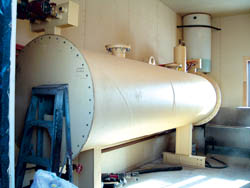
By Janis Schole, Contributing Editor
Since November, 2004, Wilfred Mollenbeck and his two sons have been enjoying money-saving heat from their home-built big round bale furnace.
It supplies heat for three houses, two hot-water tanks, and a large shop, for a total of 15,000 sq. feet.
They burn straw bales from barley, wheat and canary seed.
"The canary seed bales seems to have more heat in them and burn cleaner but cleaning out the ashes is only a half hour job, and we've only had to do it once a month," Mollenbeck says. "We built a 20-ft. long scraper that attaches to our quick-tach loader. Once we have the pile scraped up in front of the furnace, we put the bucket back on, scoop it up, and haul it away."
The furnace was built from a giant 13,000-gal. fuel tank measuring 21 ft. long and 13 ft. in dia. The Mollenbecks cut a hole in one end of the tank and inserted a 19-ft. long by 7-ft. dia. rail car tank inside. Then they cut the end off the 7-ft. tank, and used both tanks' end pieces to make a double-walled door to close off the end. The inner tank serves as the firebox and the space between the two tanks is filled with water.
"The door is the secret to the whole furnace. You want to be able to control the heat so it doesn't get too hot and boil the water out," Mollenbeck says. "There is a regular furnace blower fan built into the door. We put in automatic controls, which include forced air draft, and a damper. When it reaches 190 degrees F, everything closes off. When the temperature gets down to 170 degrees, it opens up again. Since the door weighs about 2,000 lbs., we took the big main axle from a Deere combine -- it's about 8 ft. long -- and used it to make the door hinge. This makes it easy to open."
According to Mollenbeck, most furnaces have an asbestos rope for a door seal, but he and his boys chose to use an all-steel seal, which is simpler and cheaper. It's a 1-in. by 1/8-in. flat ring that's spring-loaded, he says.
The door holds 100 gal. of water that circulates with the hot water inside the main chamber. The hottest water leaves the furnace through a 3-in. waterline at the top. It runs to a home-built heat exchanger filled with 200 gal. of anti-freeze, which in turn circulates to all the buildings. A 3-in., 1/2 hp pump circulates the water through the heat exchanger and back to the furnace.
"The heat exchanger is the key to whole system. It's a 42-in. dia. pipe that's 14 ft. long and 1/2 in. thick. The guts of it are made up of 1,000-ft. of 1-in. dia. pipe sections that are welded to two end plates. The water from the furnace boiler heats up the antifreeze in those 1-in. pipes, and 4 small 5-gal./min. pumps on the heat exchanger send the hot antifreeze to each building."
The ends of the heat exchanger are bolted on for easy access to the interior for inspection or repair.
The furnace is covered in a layer of 6-in. bat insulation and it's housed in a 14 by 24-ft. steel building to keep it out of the wind and protect the insulation from the weather.
This furnace is very clean burning, and Mollenbeck says it only smokes for the first 20 min. after he puts a bale in. On average, it requires one straw bale every 12 hours.
The 1-in. antifreeze lines run underground from the heat exchanger to the buildings, and are wrapped with foam insulation. The farthest house requires 700 ft. of line (there and back) and the family says the antifreeze temperature only drops 2 to 4( by the time it returns to the heat exchanger.
It took about a month to build the furnace, and another week to build the heat exchanger.
"We expect the furnace will pay for itself in one winter," he says.
